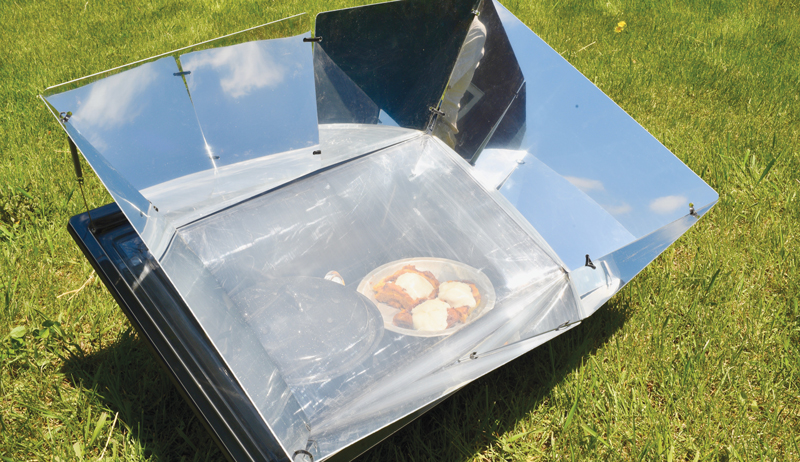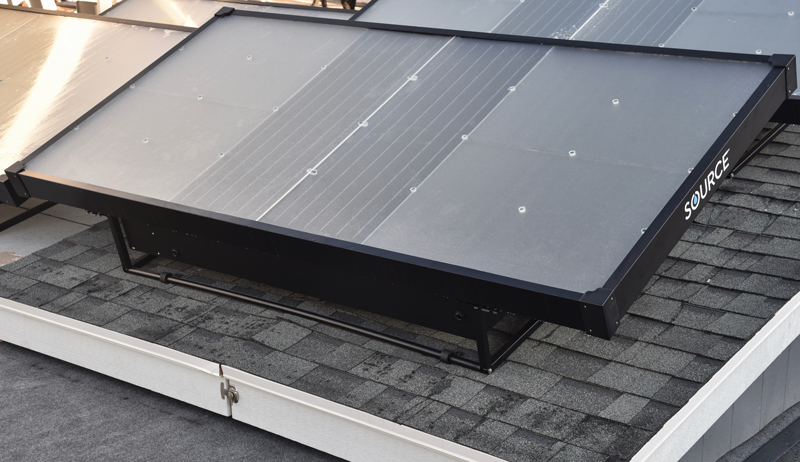
In recent years, the U.S. has been hammered by a variety of natural disasters causing damage to property and threatening lives. There were so many tornadoes, flash floods, fires and hurricanes in 2018, for example, that the year saw the fourth-highest number of billion-dollar weather-related disasters.It also was the fourth-costliest for such disasters, with an estimated $91 billion in damages. Hundreds of thousands of people had their lives and livelihoods turned upside down. If you have a plan for an off-the-grid emergency, you can ensure the safety of your family, home or property. New emergency preparedness technology can help keep you safe in a survival situation.
Many of these devices premiered at last year’s Consumer Electronics Show in Las Vegas, Nevada. They highlight solutions to key components of emergency preparedness. Most notably, the event featured communication, emergency lighting and signaling, back-up power, food preparation, water, and disaster monitoring and assessment devices.
Communications
When the power goes out and you’re forced to take shelter or evacuate, you need to keep informed, situationally aware and connected. Communication capabilities are a key part of emergency preparedness.
ION Audio Survival Scout Solar Powered Speaker
The Survival Scout speaker developed by ION Audio is designed to be the high-tech modern evolution of the classic emergency hand-crank radio. The relatively compact, 81⁄2-by-8-by-9-inch Survival Scout keeps you informed on severe weather developments from the safety of shelter without the need for power, cellular connectivity or an internet connection.
The speaker comes equipped with standard AM/FM radio. It also has seven special National Oceanic and Atmospheric Administration weather bands for emergency weather notifications. The speaker’s interface also includes an aux input and Bluetooth connectivity for pairing with mobile electronics. It features a built-in LED light strip, too.
The rugged Survival Scout features an IPX4 water-resistance rating and offers a wide variety of options to keep its 2,300-mAh battery charged. These includes a built-in solar panel, standard wall outlet charger and even a hand dynamo crank.
With USB ports located on the front of the speaker, the captured electricity can also be used to charge a phone or mobile electronics for an emergency call.
Cat Rugged Smartphone
A cell phone is indispensable during an emergency. But battery life and durability during a disaster can be a problem.
Less so with a Cat phone. The ultradurable midrange Cat S41 smartphone features an extremely durable and grippy rubber case with a massive 5,000-mAh battery. It can provide as much as 38 hours of talk time.
Furthering the rugged design, the S41 also features MIL-SPEC specifications. It has an IP68 waterproof rating, too, allowing full submersion in up to 6.56 feet of water for an hour.
This off-grid Kentucky homestead is an Amish paradise.
Emergency Lighting & Signaling
Lighting is key for navigation and safety. But when disaster strikes, you don’t want to fumble with complicated, heavy or potentially dangerous kerosene or gas lanterns.
LuminAID PackLite Nova USB
Emergency lighting doesn’t get much simpler than the PackLite Nova USB, an inflatable waterproof solar lantern by LuminAID.
A sunny day to charge and a press of a button is all it takes to get the PackLite Nova USB to produce as much as 75 lumens of safe light for five hours with an array of internal LED lights. It takes only a couple of seconds and a few puffs of air to fully inflate the lantern. This provides buoyancy and protection.
Power & Batteries, Recharging with the Sun
Mobile battery life can be a precious resource if power is taken out for an extended period of time. Keeping a small battery bank on hand can help, but it’s temporary. So keep them charged with some solar power for emergency preparedness.
Sunnybag Iconic Solar Backpack
Many emergencies involve evacuating or moving to dedicated shelters. In these situations, staying equipped, prepared and connected while on the go are your keys to safety.
With built-in charging capabilities and as much as 1,220 cubic inches of storage space, Sunnybag’s line of solar backpacks can be the perfect bag for carrying vital supplies and keeping communications online when on the move.
Sunnybag’s Iconic stylish solar backpack fits laptops as big as 17 inches. It is built with sturdy polyester fabric and mounts an included 7-watt solar panel on the bag’s exterior. The internals of the Iconic feature a variety of zippered pockets for convenient packing.
It also features padded compartments for tablets, laptops and other fragile products. Sunnybag has thoroughly padded the section of the bag that rests on your shoulders and back for added comfort during travel.
The solar energy harvested from the external detachable solar panel outputs via a USB plug that sits in one of the Iconic’s internal compartments. While outside on a sunny day, two hours is all it takes for the 7-watt solar panel to fully recharge a modern smartphone.
Mobile devices already fully charged? The Iconic’s solar panel easily connects to a portable USB battery bank to store the surplus power for future use.
For those looking to go lighter, Sunnybag also produces the Explorer+. This smaller backpack can accommodate 15-inch laptops with a total volume of 915 cubic inches and a detachable 6-watt solar panel.
Solar thermal systems heat your water with the sun.
ToughTested Bigfoot
The Bigfoot solar battery bank from ToughTested keeps mobile electronics charged and connected for emergency situations. With a massive 24,000-mAh internal battery and 400-mAh solar panel for passive recharging, the Bigfoot can charge up anything from mobile electronics to small laptops using its built-in USB and USB-C ports.
It’s built to be reliable in rough conditions when needed most. The Bigfoot weighs 1.65 pounds and is built with study plastics, featuring rubber covers on charging ports and bumpers to protect the battery bank from falls. Also, its IP67 waterproof rating means the device can be safely submerged under 3 feet of water for as long as 30 minutes.
The Bigfoot also includes a potentially life-saving feature. The solar power bank’s design incorporates a built-in LED flashlight with a special mode that blinks out the SOS pattern, on repeat.
With a full charge, it can produce this emergency signal for an estimated 88 continuous hours.
Cooking & Water Purification
When traditional refrigeration and power goes out, emergency preparedness requires a solid plan for safely cooking. You also need to prevent foods from spoiling. Solar ovens offer one of the easiest ways to cook fresh produce, meats and other perishable foods.
You can even pasteurize water without the need for gas, wood or any electricity.
GoSun Sport Solar Oven
The GoSun Sport has a uniquely narrow folding design that allows for impressive portability. Its central 2-foot long and 2.1-inch wide cooking chamber with a pair of fold-out solar reflector wings that concentrate solar energy, allowing the oven to reach temperatures as hot as 550 degrees Fahrenheit.
Perfect for safely cooking a delicious meal of meats, produce or even pastries using sunshine.
Solavore Sport Solar Oven
The Solavore Sport features a more traditional boxy solar oven design with a fold-out reflector. It provides significantly more oven space while maintaining a max temperature of 300 degrees Fahrenheit.
The Solavore Sport’s design allows it to pasteurize water in a pinch. It heats water for an extended period of time and authenticates safety with a water-pasteurization indicator.
Here are 6 tips for using an ag drone on a small farm.
Monitoring & Damage Assessment
In the immediate aftermath of an emergency, safely inspecting the situation and assessing damage can be crucial for deciding the proper course of action.
Over the past five years, consumer drones with photo and 4K video capabilities have exploded in popularity. And now prices are more affordable, too.
Drones provide a quick way to get an eye in the sky and investigate emergency situations. You can review livestock and assess buildings, all from the safety of your front porch.
Increasingly, people use drones to capture aerial documentation of damages, a potentially valuable asset for expediting insurance assessments.
DJI Phantom 4 Pro and DJI Spark
The more popular drones include DJI’s Mavic and Phantom 4 Pro lines with prices ranging from $1,000 to $2,000. DJI’s $400 Spark drone fits in the palm of your hand.
These drones provide as much as 30 minutes of flight time. They also offer technologies such as GPS stabilization and collision-avoidance systems that help make drone flights easy and safe.
Water Supply
Most people “living off the grid” do so with photovoltaics powering their home. But these systems often still tie into the grid.
In the event of a power outage, grid-tied systems go down as well. Then, pumping water from a well or letting it flow from a faucet is no longer possible.
Why not take your water supply off the grid as part of you emergency preparedness, too?
Zero Mass Water SOURCE Hydropanel
Zero Mass Water has engineered a safe, sustainable and easy way to provide clean drinking water to your home with their SOURCE Hydropanel.
Their proprietary collection system can capture between 8 to 20, 16.9-ounce bottles of water per day, depending on the climate where it’s located. Unlike well pumps, the SOURCE is completely self-powered thanks to a built-in solar panel, with an internal battery to power moisture collection on cloudy days.
This article appeared in Living Off the Grid, a 2019 specialty publication produced by the editors and writers of Hobby Farms magazine. Living Off the Grid includes stories on permaculture, growing plants without seeds and long-term produce storage. You can purchase this volume, Hobby Farms back issues as well as special editions such asBest of Hobby Farms and Urban Farm by following this link.




